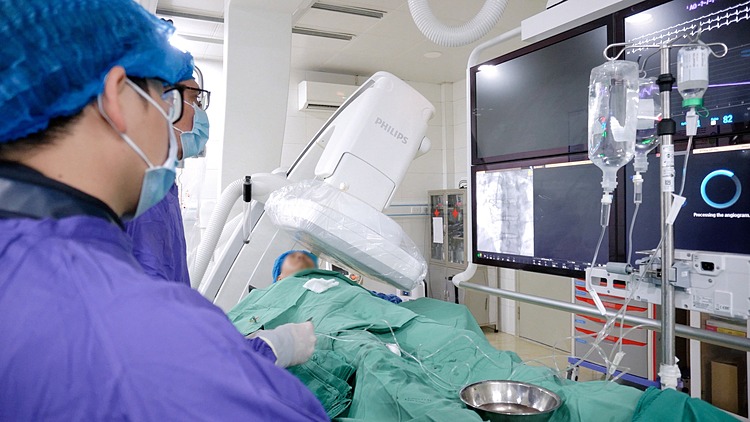On 3/8, representatives from Hung Vuong General Hospital reported that the patient's chest pain began two hours before he arrived at the hospital – a crucial timeframe for life-saving intervention. The patient had a history of kidney stones and regularly smoked cigarettes and tobacco.
Doctors diagnosed an acute myocardial infarction. Coronary angiography revealed a complete blockage in the mid-LAD (p-m) branch, a leading cause of death from heart attacks.
The interventional cardiology team promptly placed a coronary stent to restore blood flow to the heart, saving the patient's life.
 |
Doctors treating the patient. Photo: Hospital provided |
Non-communicable diseases are the leading cause of death in Vietnam, accounting for about 80% of all deaths. Cardiovascular disease is the primary culprit, responsible for 39.5% of these deaths.
The World Health Organization (WHO) estimates 17.5 million people die annually from cardiovascular diseases globally. Among these, myocardial infarction is a medical emergency; without prompt treatment, the mortality rate is 50%. According to the American Heart Association, the incidence of acute myocardial infarction in younger patients, under 45, has been increasing and currently represents 6-10% of all acute myocardial infarction cases. This is a significant cause of illness and death in young people worldwide.
The symptoms of a heart attack are relatively similar in younger and older individuals. The typical symptom is severe chest pain, located in the center of the chest, behind the sternum, or slightly to the left. The pain is described as heavy, squeezing, tightening, or pressing, sometimes radiating to the left arm, jaw, or upper abdomen. The chest pain typically lasts 20-30 minutes or longer. Patients may experience sweating, shortness of breath, and loss of consciousness.
Besides congenital factors and underlying conditions, the primary cause of heart attacks in younger individuals is lifestyle, including being overweight, lack of exercise, stress, and tobacco and alcohol abuse. This group often assumes their youth protects them from diseases typically associated with older age. They only realize they are having a heart attack when they experience severe chest pain and are hospitalized. In many cases, by the time they arrive at the hospital, they have already suffered heart muscle damage, heart failure, or sudden cardiac death.
Like the aforementioned patient, heavy and prolonged smoking is a significant risk factor for acute myocardial infarction. Long-term smoking causes chronic atherosclerosis in all blood vessels throughout the body. These atherosclerotic plaques gradually narrow the arteries, leading to heart attacks and strokes.
Other factors such as high blood pressure, high blood sugar, and family history increase the risk. If not well-managed, abnormal blood lipid levels will cause atherosclerosis, leading to heart attacks, strokes, and peripheral artery disease. According to hospital records, the rates of hypertension and diabetes have been rapidly increasing over the past 10 years, contributing significantly to the increasing incidence of heart disease in younger individuals.
Doctors recommend controlling risk factors and maintaining a healthy weight. Limit alcohol consumption, quit smoking, eat plenty of vegetables, fruits, and whole grains; avoid fast food, processed fats, and fried foods. Engage in physical activity for 30-60 minutes per day, 5 days a week.
From the age of 40 onwards, individuals should undergo regular checkups, including heart ultrasound, electrocardiogram (ECG), and blood tests for lipids, glucose, and blood pressure.
Younger individuals should not mistakenly believe that heart attacks only affect older people and ignore the signs, which can lead to serious complications. Seek immediate medical attention if you experience any unusual symptoms such as chest pain, shortness of breath, or irregular heartbeat. Individuals experiencing a heart attack need to have blood flow restored to the heart as soon as possible. The golden window is the first 48 hours, especially the first 12 hours.
Thuy Quynh












